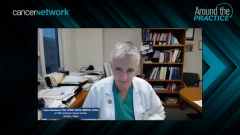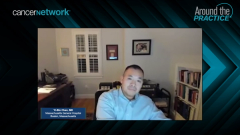
Case 2: Treatment Decisions for a Patient With Chronic GVHD
Reactions to a case of chronic graft-vs-host disease and thoughts on sequencing therapy.
Episodes in this series

Parameswaran Hari, MD, MRCP: This is the ideal time to go to the next patient case. This is a 65-year-old woman who had a matched unrelated donor transplant for AML [acute myeloid leukemia] with myeloablative conditioning with Bu/Cy [busulfan/cyclophosphamide] and tacrolimus/methotrexate as GVHD [graft-vs-host disease] prophylaxis. Three months after transplant, she developed grade 2 acute graft-vs-host disease of skin and oral mucosa and was treated with topical steroids and oral rinse and responded.
About 14 months after transplant, she reported a sensation of dry eyes and was treated with eye drops by the ophthalmologist. There was also muscle and joint pain limiting activities of daily living that responded to prednisone that was tapered off after 3 months. At this point, the patient didn’t have much follow-up for the next 2 months. At 20 months, she came to the BMT [bone marrow transplant] clinic after a 2-month delay and had significance scleroderma at that point. We don‘t know the extent of the skin involvement, but there was definitely decreased range of motion in her knees and hips. She’s been off of steroids for 3 months, so this isn’t an enemy to the taper. This isn’t progressive disease on steroids. The question to the audience is: What would be the next agent to try? Attempt prednisone again, oral methotrexate, ruxolitinib [Jakafi], ibrutinib [Imbruvica], rituximab [Rituxan], or a combination of prednisone plus another agent?
This time, the audience is split between ruxolitinib and the combination of prednisone plus another agent. There’s a small amount of support for attempting prednisone again as a single agent. The treatment of chronic GVHD is an art, and you need a bit of luck, too. It’s not really a pure science. I‘m going to go to the most experienced transplanter in our group, Dr Chao. Nelson, what do you think? How would you approach this?
Nelson J. Chao, MD, MBA: The data would suggest ruxolitinib. The ruxolitinib data are quite robust. It’s actually approved as a second-line treatment. For us, the same as with ruxolitinib for acute GVHD, sometimes it’s difficult with chronic GVHD if patients are thrombocytopenic or pancytopenic because they’re recently post-transplant or because of their chronic GVHD. It’s probably what we’d go to next. If a patient is local, we tend to use ECP [extracorporeal photopheresis], primarily because it isn’t a drug. We think of it as being less immunosuppressive. It’s a little more difficult if they don’t live locally, because it’s not available everywhere, but that’s probably the 2 choices we’d have.
Parameswaran Hari, MD, MRCP: Thank you. We’d also tend to use ECP in local patients in this setting, those who can show up 2 times a week for several weeks in a row. In the interest of time, I’m going to the next audience question. Assuming this patient was retreated with prednisone, and assuming the patient doesn’t have any adequate response to prednisone, what would you try next? The choices here are imatinib [Gleevec], ECP, ruxolitinib, or rituximab.
Yi-Bin Chen, MD: While we wait, I’ll say that part of it is examining this patient. You obviously hope to get the patient before they develop scleroderma. When all of us see scleroderma, we feel this sinking feeling. You obviously hope to catch them before. If they’re far away, that goes back to being able to have a method of communication, patient education, and teaching them what to recognize, because I’m sure they felt this before you’re actually seeing it. But if the skin is really red, there’s active inflammation, and adding steroids plus or minus something else makes sense. But if it‘s just pure scleroderma, it would hurt me to put the patient back on prednisone.
Joyce Neumann, PhD, APRN, AOCN, BMTCN, FAAN: We may use prednisone as something to get the process under control more quickly, knowing that some of these other agents may take a little more time. In that last scenario, we’d probably say ECP and ruxolitinib would be the choices, but sometimes prednisone if something seems very active, just to put the brakes on it or slow it down to let these other agents work and kick in.
Parameswaran Hari, MD, MRCP: There’s actually clear-cut steroid failure at this time. The majority of our audience have chosen ruxolitinib, a small minority have chosen ECP, and an even smaller minority have chosen rituximab, which as you know isn’t approved at this point. But if you want B-cell suppression, the approved B-cell suppressing drug is ibrutinib.
Transcript edited for clarity.
Newsletter
Stay up to date on recent advances in the multidisciplinary approach to cancer.



















































































